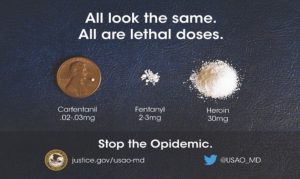Opioids are a class of drugs used to reduce acute and chronic severe pain. They work by attaching to opioid receptors in your brain cells to release signals that block your perception of pain and boost your feelings of pleasure.

Do you know what’s in your medicine cabinet or drawer? Prescription opioids come in many different forms from the pharmacy including syrups, pills, and patches. Talk to your doctor or pharmacist about the medications you’re taking.
Opioid pain medication is addictive. Make sure you’re taking the medicine as prescribed. Talk with your doctor about getting the correct dose and available alternative treatment options.
Store opioid medication in a safe place: out of sight and out of reach of visitors.

Illicit opioids are illegal non-prescription opioids such as heroin and illicitly-manufactured fentanyl (IMF).
Illicitly-manufactured fentanyl (IMF) is sold through illegal drug markets for heroin-like effects. Fentanyl is often mixed with heroin and/or cocaine to increase euphoric effects, with or without the person who is using the substance’s knowledge. The lethal dose of fentanyl is 2 milligrams.
Risks of taking opioids may include:
- Side effects such as sedation, constipation, or respiratory depression
- Dependence
- Hep C/HIV through shared needles
- Pregnancy complications
- Overdose or death
Chances of an opioid overdose increase when:
- Opioids are taken with alcohol, other opioids, or sedatives (like Valium or Xanax).
- Opioids are taken in larger amounts or more often than prescribed.
- Opioids are taken at previous doses after a long break (such as after being released from the hospital or prison/jail).
- Rotating from one opioid medication to another.
- Other medical diseases are present such as lung disease, sleep apnea, or kidney or liver problems.
- There is a history of substance abuse or nonmedical opioid use.
- Starting long-acting opioids as initial opioid treatment.
Eastern Idaho Public Health provides information and presentations to community members and organizations about the current state of opioid use in Idaho, safe storage and disposal of prescription opioids, illicit opioids, opioid overdose warning signs, availability of naloxone, how to administer naloxone, and Idaho’s Good Samaritan Law. Presentations include overdose recognition and demonstrations of nasal naloxone. To schedule a training or for questions, call Mallory Johnson at (208) 533-3221.
- Idaho’s Response to the Opioid Crisis (IROC) Wallet Card: This wallet card lists substance use recovery telephone numbers.
- Click here to request a wallet card be sent to you or your organization.
- Eastern Idaho Community Resources: Resources include substance use recovery resources as well as housing, employment, financial aid, food assistance, and more.
- Click here to access the Eastern Idaho Public Health Community Resource Asset Map.




